1. Why use a flatbed truck trailer in Senegal?
2. What are the specs of a flatbed truck trailer in Senegal?
3. How should you transfer a load on a flatbed truck trailer?
4. How do you secure cargo on a flatbed truck trailer?
In the diverse landscape of Senegal, transportation plays a crucial role in economic growth and development. As the country strives to enhance its infrastructure and logistics networks, the choice of truck trailers becomes pivotal. Among the various options available, flatbed truck trailers stand out as an efficient and versatile choice for transporting goods across the nation.
1. Versatility in Cargo Transportation
Flatbed truck trailers are an excellent choice for Senegal due to their versatility in transporting different types of cargo. The open design of these trailers allows for easy loading and unloading of various goods, ranging from construction materials, agricultural products, machinery, and oversized equipment. In a country with diverse industries and resources, the ability to haul an assortment of cargo is invaluable for fostering economic growth and development.
2. Overcoming Infrastructural Challenges
Senegal's road infrastructure, while steadily improving, can still present challenges for transportation. With varying road conditions, including uneven surfaces, potholes, and narrow passages, flatbed truck trailers offer an advantage over traditional enclosed trailers. Their design allows for better weight distribution and stability, making them better equipped to navigate through difficult terrains, ensuring the safe delivery of goods to even the most remote areas.
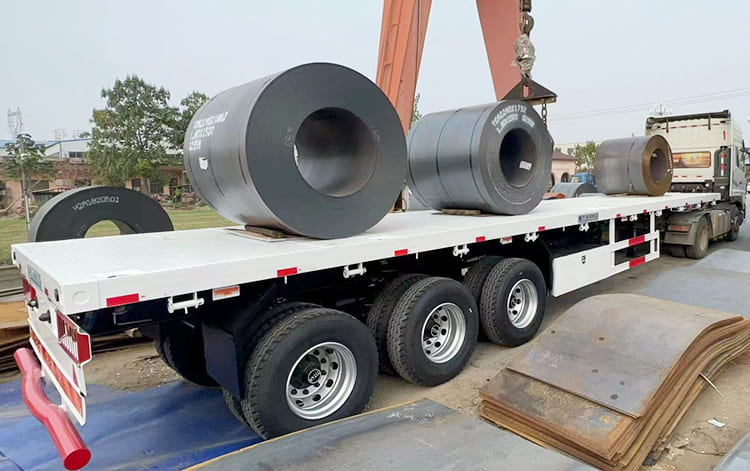
Why use a flatbed truck trailer in Senegal?
3. Cost-Effectiveness
In a country where cost-efficient transportation solutions are essential, flatbed truck trailers prove to be an economical option. Due to their uncomplicated design, flatbed trailers are relatively easier and cheaper to manufacture and maintain than specialized trailers. Moreover, their ability to carry diverse cargo means businesses can optimize transportation costs by utilizing the same trailer for various shipments.
4. Expediting Loading and Unloading
Time is of the essence in the logistics industry, and the quick loading and unloading capabilities of flatbed truck trailers can make a significant difference in improving efficiency. Traditional enclosed trailers may require extensive labor and time to load and unload, especially for bulky or irregularly shaped cargo. Flatbed trailers eliminate this challenge, streamlining the process and reducing turnaround times, ultimately benefiting both transporters and their clients.
5. Facilitating Oversized Cargo Transportation
Certain industries in Senegal deal with oversized and irregularly shaped cargo that necessitate specialized transportation solutions. Flatbed truck trailers are uniquely suited to handle such challenging loads, making them ideal for industries such as construction, energy, and mining. Whether it's large machinery, construction components, or wind turbine parts, flatbed trailers can safely transport these cumbersome items, contributing to the growth of specialized sectors within the country.
6. Promoting Safety and Security
Safety is a paramount concern in the transportation industry, and flatbed truck trailers offer distinct advantages in this aspect. Their open design allows for easy inspection of the cargo before and during transportation, reducing the risk of hidden damage or potential hazards. Additionally, flatbed trailers come equipped with securement mechanisms to firmly tie down the cargo, minimizing the chances of accidents or cargo displacement during transit.
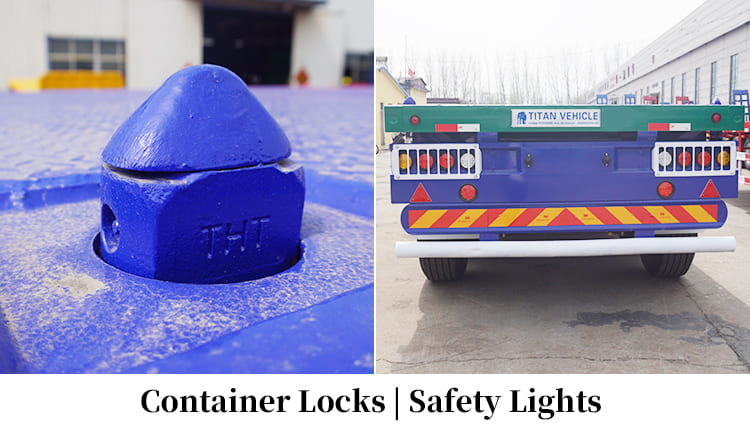
Promoting Safety and Security of Flatbed Truck Trailer
As Senegal continues to progress in its economic development and infrastructure enhancement, the importance of efficient and reliable transportation cannot be understated. Flatbed truck trailers provide a compelling solution, offering versatility, cost-effectiveness, and safety in transporting diverse goods across the country's varied terrain. By harnessing the advantages of flatbed trailers, businesses can expedite their supply chains, promote industrial growth, and contribute to Senegal's overall economic prosperity.
As Senegal's economy continues to thrive, the demand for efficient transportation of goods across the nation has grown exponentially. Among the various types of trailers utilized in the logistics industry, flatbed truck trailers play a vital role in meeting the diverse transportation needs of different industries. In this article, we delve into the essential specifications of flatbed truck trailers used in Senegal, shedding light on their design, capabilities, and features that make them indispensable for cargo transportation in the country.
1. Dimensions and Load Capacity
Flatbed truck trailers in Senegal are designed to accommodate varying dimensions of cargo. Typically, these trailers have a length ranging from 12 to 15 meters (40 to 50 feet) and a width of approximately 2.5 to 2.6 meters (8 to 8.5 feet). The height of the trailer's bed is generally around 1 meter (3.3 feet). As for load capacity, flatbed trailers in Senegal can carry weights varying from 20 to 30 tons, depending on the specific model and axle configuration.
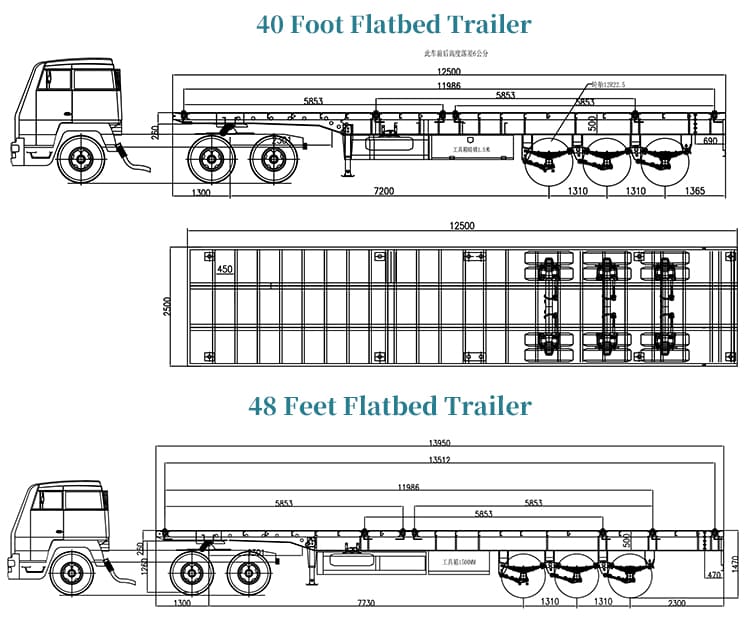
What are the specs of a flatbed truck trailer in Senegal?
2. Deck Material and Construction
The deck or bed of a flatbed truck trailer is constructed from sturdy materials to withstand the weight and pressure of various cargo. Common materials used for the deck include steel, aluminum, or a combination of both. Steel decks offer exceptional strength and durability, making them suitable for transporting heavier loads, while aluminum decks are lighter, providing better fuel efficiency and corrosion resistance.
3. Number of Axles
The number of axles on a flatbed truck trailer significantly influences its load-carrying capacity and maneuverability. In Senegal, flatbed trailers are commonly available in configurations with two to three axles. Two-axle trailers are suitable for lighter loads and provide better maneuverability, making them ideal for urban or shorter-distance transportation. On the other hand, three-axle trailers offer higher load capacities and better weight distribution, making them well-suited for long-haul journeys and transporting heavier cargo.
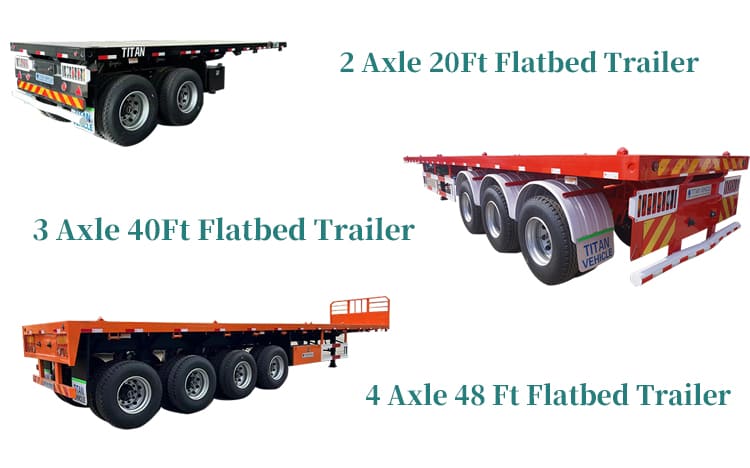
What are the specs of a flatbed truck trailer in Senegal?
4. Loading and Unloading Mechanisms
Efficient loading and unloading mechanisms are crucial for maximizing productivity and minimizing downtime in the transportation industry. Flatbed truck trailers in Senegal are equipped with various loading and unloading options, such as forklift pockets, stake pockets, and tie-down points. These features allow for secure attachment of cargo and enable easier loading and unloading processes, ensuring smooth and swift operations at loading and delivery points.
5. Safety Features
Safety is a top priority when it comes to cargo transportation. Flatbed truck trailers in Senegal come equipped with safety features to protect the cargo, the vehicle, and the surrounding traffic. Some common safety features include anti-lock braking systems (ABS), reflective markings for visibility, and securement devices such as chains and straps to prevent cargo shifting during transit. Regular maintenance and inspections are also carried out to ensure the trailers are in optimal working condition, reducing the risk of accidents on the road.
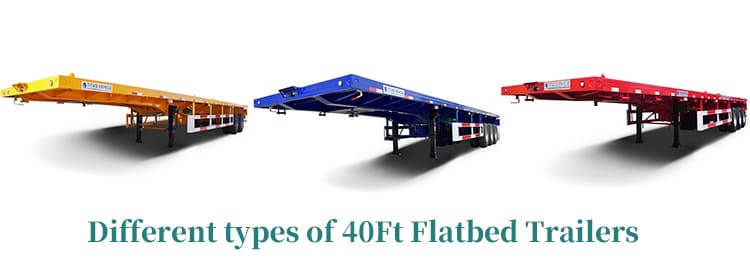
What are the specs of a flatbed truck trailer in Senegal?
6. Legal Compliance
Compliance with local regulations and transportation laws is essential for smooth operations and avoiding penalties. Flatbed truck trailers in Senegal adhere to the country's legal requirements regarding vehicle dimensions, weight restrictions, and safety standards. It is imperative for trucking companies and drivers to be well-versed in these regulations to ensure that their operations are lawful and safe.
Flatbed truck trailers in Senegal are a crucial component of the country's logistics and transportation infrastructure. With their versatility, robust construction, and diverse loading options, these trailers efficiently handle various types of cargo, supporting industries ranging from construction to agriculture. Understanding the specifications and capabilities of flatbed truck trailers allows businesses to make informed decisions about their transportation needs, ensuring the seamless movement of goods across Senegal's diverse landscape and contributing to the nation's economic growth and prosperity.
Flatbed truck trailers are indispensable in the transportation industry for their versatility in carrying a wide range of cargo. Whether it's construction materials, heavy machinery, or oversized goods, flatbed trailers provide an open platform that allows for easy loading and unloading. However, to ensure the safe and secure transportation of goods, proper load transfer procedures must be followed. In this article, we will explore the best practices for transferring a load on a flatbed truck trailer to ensure a smooth and incident-free journey.
1.Plan and Prepare
Proper planning is the foundation of a successful load transfer operation. Before loading the cargo onto the flatbed trailer, carefully assess the dimensions, weight, and characteristics of the load. Ensure that the trailer is suitable for accommodating the cargo and that its weight does not exceed the trailer's capacity. It's essential to calculate the load's center of gravity to distribute the weight evenly on the trailer and prevent imbalance during transit.
2. Check the Trailer's Condition
Before transferring the load, thoroughly inspect the flatbed trailer to ensure it is in optimal condition. Check for any signs of damage, wear and tear, or loose components that might compromise the trailer's stability. Verify that all securing mechanisms, such as chains, straps, and binders, are in good working order and rated for the load's weight and dimensions.
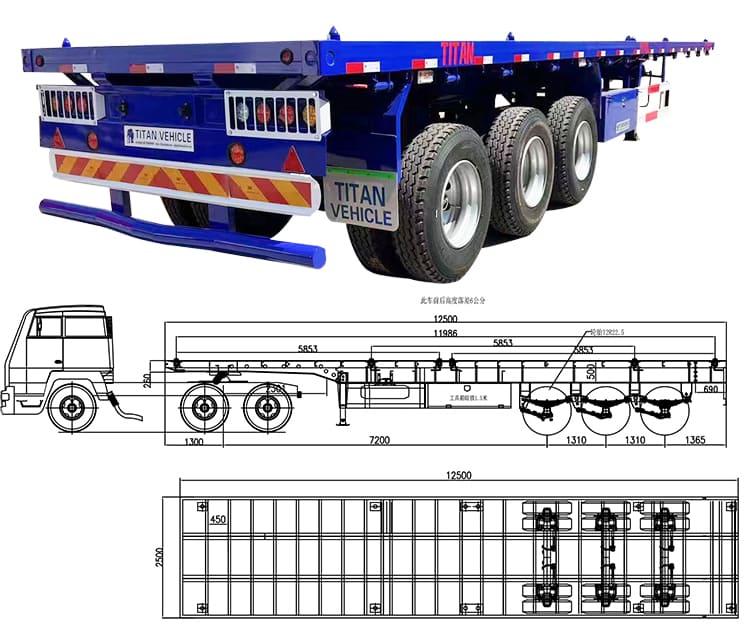
How should you transfer a load on a flatbed truck trailer?
3. Use Proper Loading Equipment
To facilitate safe loading and unloading, use appropriate equipment such as forklifts, cranes, or loading docks. Ensure that the loading equipment is capable of handling the load's weight and size without causing damage to the cargo or the trailer. When using forklifts, employ pallets or skids to distribute the load's weight evenly and avoid placing excessive stress on specific areas of the trailer's bed.
4. Secure the Load Adequately
Securing the load is perhaps the most critical aspect of load transfer on a flatbed truck trailer. Neglecting to secure the cargo properly can result in shifting during transit, leading to accidents and damage. Utilize a combination of tie-down points, chains, straps, and binders to fasten the load securely to the trailer. Make sure the load is centered on the trailer and tightly secured to prevent lateral movement and forward or backward shifting.
5. Use Edge and Corner Protection
To safeguard both the cargo and the flatbed trailer from damage during loading and unloading, use edge and corner protection materials. These protective devices act as buffers between the cargo and the trailer's surface, preventing friction-related damage and minimizing the risk of abrasions or scratches.
6. Perform Final Checks
Before hitting the road, conduct a comprehensive final inspection. Ensure all securing devices are correctly tensioned and secured, and double-check that no part of the cargo extends beyond the permissible limits of the flatbed trailer. Verify that reflective markings and warning signs are appropriately placed to enhance visibility, especially during nighttime or adverse weather conditions.
Transferring a load onto a flatbed truck trailer requires careful planning, attention to detail, and adherence to safety protocols. Proper load transfer not only ensures the cargo's safe transportation but also contributes to the overall efficiency of the logistics process. By following best practices, including meticulous planning, inspection, and securing the load adequately, businesses can maintain a stellar safety record, reduce the risk of accidents, and build a reputation for reliable and responsible transportation services. Ultimately, prioritizing load transfer safety on flatbed truck trailers promotes a culture of professionalism and contributes to the success of the transportation industry as a whole.
Flatbed truck trailers are an essential part of the transportation industry, providing a versatile and open platform for carrying a wide array of goods. However, the open nature of flatbed trailers requires special attention to secure the cargo properly. Ensuring that the load is securely fastened is crucial for safe transportation, preventing accidents, damage to the cargo, and hazards to other road users. In this article, we will explore the best practices for securing cargo on a flatbed truck trailer to ensure a smooth and incident-free journey.
1. Choose the Right Equipment
Before you start securing the cargo, ensure you have the appropriate equipment. Commonly used tools for securing cargo on a flatbed trailer include:
Straps: Made of durable polyester, straps are flexible and can be easily adjusted to fit the cargo securely.
Chains: Sturdy chains with hooks are suitable for heavy loads and provide added strength and security.
Binders and Winches: These tensioning devices help tighten straps and chains securely around the cargo.
Edge Protectors: Used to protect straps from sharp edges of the cargo and prevent damage.
Tarps: When transporting goods vulnerable to weather conditions, use waterproof tarps to shield the cargo from rain, dust, or debris.
2. Plan the Load Placement
Effective load placement is essential for ensuring that the cargo remains stable during transit. Before securing the load, plan its placement on the flatbed trailer. Position the heaviest and largest items at the center of the trailer to distribute the weight evenly. This practice helps maintain balance and stability during acceleration, deceleration, and turns.
Use Proper Securing Techniques
When securing the cargo, use a combination of straps, chains, binders, and winches to create a cradle-like configuration that holds the cargo in place. Follow these guidelines:
Tension the Straps and Chains: Tighten the straps and chains to secure the load firmly without over-tensioning, which could damage the cargo or trailer.
Avoid Sharp Bends: Ensure that straps and chains do not undergo sharp bends or angles that may weaken their holding capacity.
Use Corner and Edge Protectors: Place corner and edge protectors at vulnerable points to prevent straps or chains from rubbing against sharp edges and causing damage.
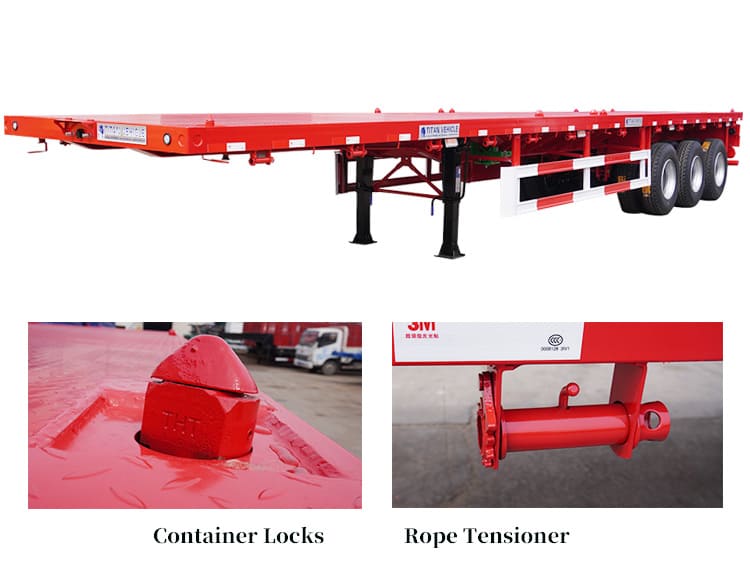
How do you secure cargo on a flatbed truck trailer?
4. Employ the Right Number of Tie-Down Points
Flatbed trailers come with designated tie-down points strategically placed along the trailer bed. Use these anchor points to secure the cargo effectively. The number of tie-down points required depends on the size and weight of the load. As a general rule, utilize at least one tie-down point for every 10 feet of cargo length.
5. Regularly Inspect and Maintain Equipment
Frequent inspections and maintenance of securing equipment are crucial for safe transportation. Check straps, chains, and binders for signs of wear, fraying, or damage before each trip. Replace any faulty or weakened equipment promptly to ensure the load remains secure throughout the journey.
6. Consider Load Covers
In certain situations, it may be necessary to protect the cargo from environmental elements during transportation. Use weather-resistant tarps or load covers to shield goods from rain, snow, or excessive sunlight. Secure the covers adequately to prevent them from dislodging during transit.
Securing cargo on a flatbed truck trailer is a meticulous process that requires careful planning, proper equipment, and adherence to safety guidelines. By selecting the right securing tools, distributing the load strategically, and performing regular inspections, businesses can ensure the safe transportation of goods and minimize the risk of accidents or damage. Prioritizing cargo security not only protects the valuable freight but also promotes a culture of safety within the transportation industry, ensuring a smooth and successful journey for both the cargo and the flatbed truck trailer.